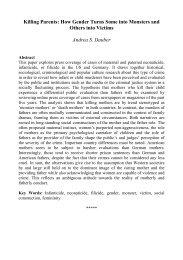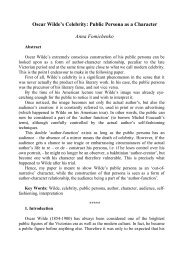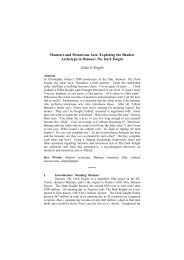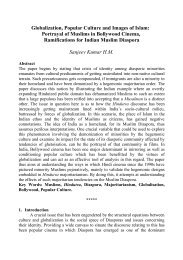“These three avant-garde designers have become an international ...
“These three avant-garde designers have become an international ...
“These three avant-garde designers have become an international ...
Create successful ePaper yourself
Turn your PDF publications into a flip-book with our unique Google optimized e-Paper software.
a montage of his sketches <strong>an</strong>d fabrics strewn across the floor, garments in progress, <strong>an</strong>d<br />
even the office of the première d’atelier. Elsewhere, <strong>an</strong>tiques, books, <strong>an</strong>d historic<br />
clothing from the museum's archives illustrated Yamamoto’s inspiration. The second<br />
floor display showed Yamamoto’s garments in a French history of costume narrative, the<br />
only of the <strong>three</strong> installations to do so. Here, the curators displayed a selection of designs<br />
they considered best represented the designer’s development from the early 1980s to the<br />
present, eighty-five percent of which where the same garments from Correspondences,<br />
terminating in a final confrontation that paid tribute to Dior, Vionnet, Mme. Grès, <strong>an</strong>d<br />
Ch<strong>an</strong>el. Here, too, certain garments were not hidden behind display cases allowing for<br />
visitors to touch them, a first for the museum.<br />
The final stop of the triptych was Dream Shop at the ModeMuseum. In Dream shop,<br />
the museum’s first exhibition dedicated to one designer, visitors could revel in the<br />
materiality of Yamamoto’s clothes: out of eighty silhouettes from the late 1980s to today,<br />
visitors could try on about twenty in a white, dream-like space with neon-lit ch<strong>an</strong>ging<br />
cubicles. This interactive experience goes against the mindset of conservation <strong>an</strong>d basic<br />
museum etiquette. Nathalie Ours, a Yamamoto spokesperson, explained that this was the<br />
first exhibition that corresponded to the designer’s concept of the viewer’s direct <strong>an</strong>d<br />
“living” relationship to the garment. 45 In most cases, the tr<strong>an</strong>sformation of “living”<br />
garments into “dead” objects on display dist<strong>an</strong>ces them from their original context <strong>an</strong>d<br />
from the audience. Here, however, viewers perceived the clothes as consumable items.<br />
This interactive experience became a commercial one, simulating the store environment,<br />
as the spectators quickly attuned themselves to the rhythm of h<strong>an</strong>dling <strong>an</strong>d trying on the<br />
clothes, thus acting as a stimulus to purchase. Here, exhibition, publicity, <strong>an</strong>d commercial<br />
14

















